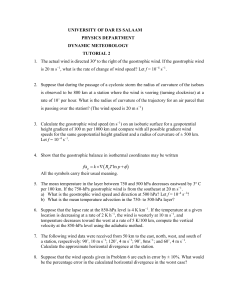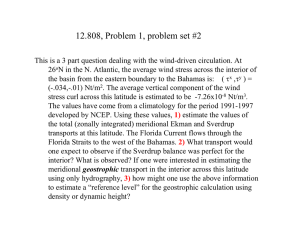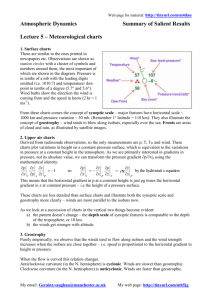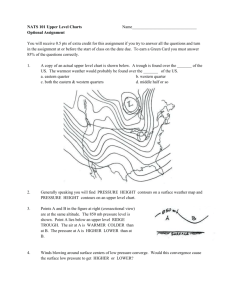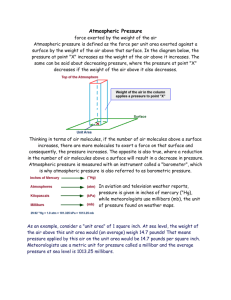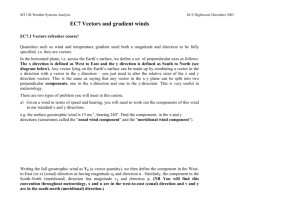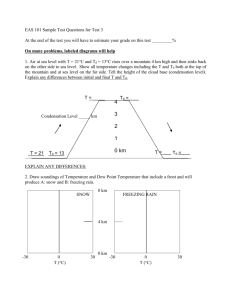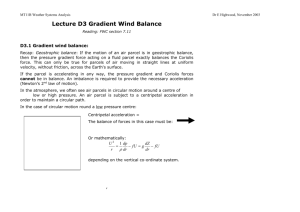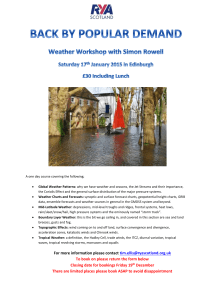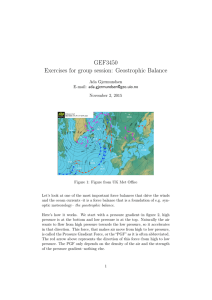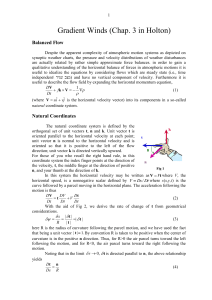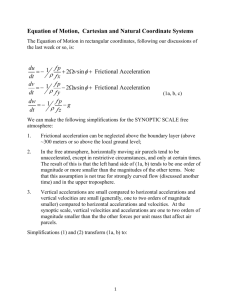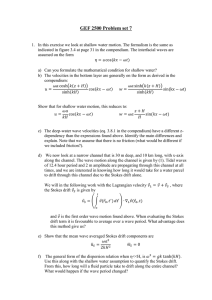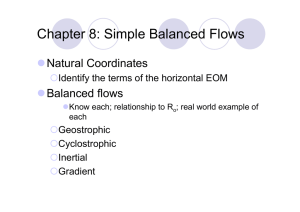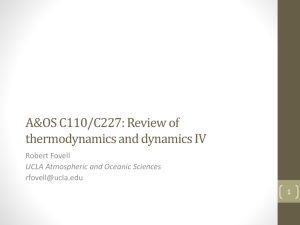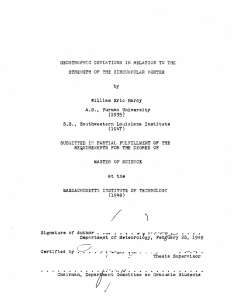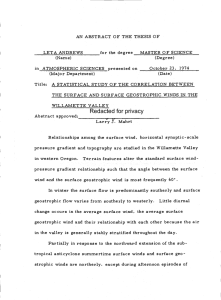P9 Upper Air Analysis: geostrophic and gradient wind
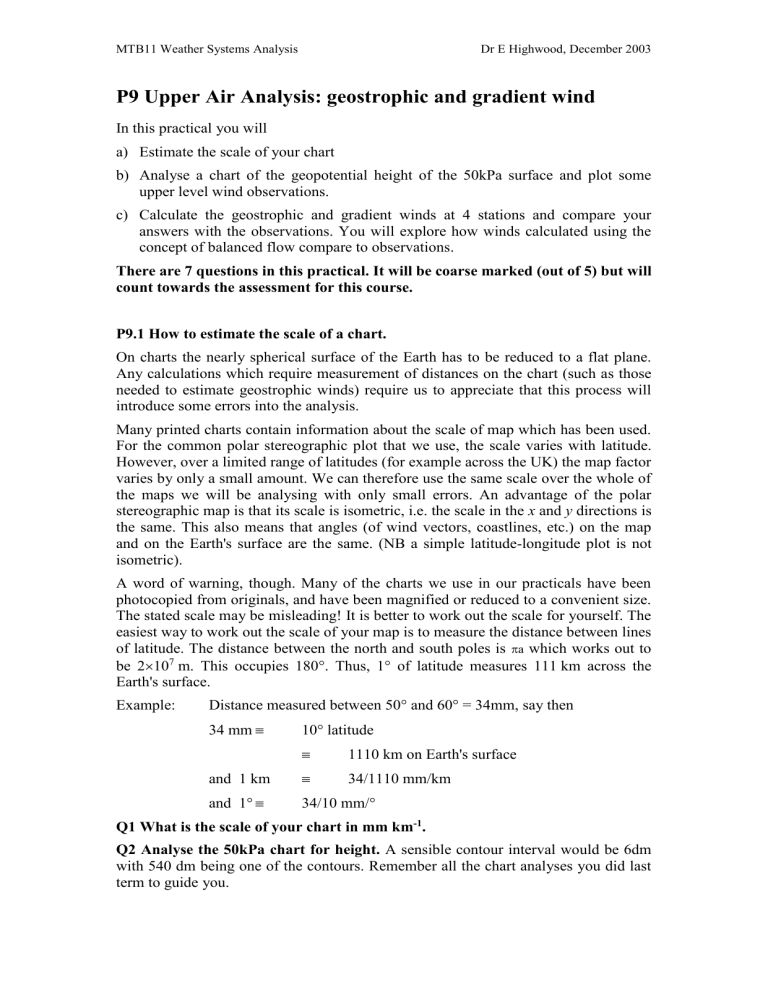
MTB11 Weather Systems Analysis Dr E Highwood, December 2003
P9 Upper Air Analysis: geostrophic and gradient wind
In this practical you will a) Estimate the scale of your chart b) Analyse a chart of the geopotential height of the 50kPa surface and plot some upper level wind observations. c) Calculate the geostrophic and gradient winds at 4 stations and compare your answers with the observations. You will explore how winds calculated using the concept of balanced flow compare to observations.
There are 7 questions in this practical. It will be coarse marked (out of 5) but will count towards the assessment for this course.
P9.1 How to estimate the scale of a chart.
On charts the nearly spherical surface of the Earth has to be reduced to a flat plane.
Any calculations which require measurement of distances on the chart (such as those needed to estimate geostrophic winds) require us to appreciate that this process will introduce some errors into the analysis.
Many printed charts contain information about the scale of map which has been used.
For the common polar stereographic plot that we use, the scale varies with latitude.
However, over a limited range of latitudes (for example across the UK) the map factor varies by only a small amount. We can therefore use the same scale over the whole of the maps we will be analysing with only small errors. An advantage of the polar stereographic map is that its scale is isometric, i.e. the scale in the x and y directions is the same. This also means that angles (of wind vectors, coastlines, etc.) on the map and on the Earth's surface are the same. (NB a simple latitude-longitude plot is not isometric).
A word of warning, though. Many of the charts we use in our practicals have been photocopied from originals, and have been magnified or reduced to a convenient size.
The stated scale may be misleading! It is better to work out the scale for yourself. The easiest way to work out the scale of your map is to measure the distance between lines of latitude. The distance between the north and south poles is a
which works out to be 2
10
7
m. This occupies 180
. Thus, 1
of latitude measures 111 km across the
Earth's surface.
Example: Distance measured between 50
°
and 60
°
= 34mm, say then
34 mm
10
latitude
and 1 km and 1
1110 km on Earth's surface
34/1110 mm/km
34/10 mm/
Q1 What is the scale of your chart in mm km -1 .
Q2 Analyse the 50kPa chart for height. A sensible contour interval would be 6dm with 540 dm being one of the contours. Remember all the chart analyses you did last term to guide you.
MTB11 Weather Systems Analysis Dr E Highwood, December 2003
Q3. Plot the following wind observations at the correct stations.
Station Longitude Latitude Wind speed
(knots)
Direction
Valentia
Hemsby
10.5
W
1.7
E
18.4
E
52
N
53.7
N
57.7
N
86
72
From 280
From 285
From 230
Visby
Aerologiska
Schleswuig 9.5
E
46
88
Check whether you need to refine your height analysis for it to be consistent with the speed and direction of these wind observations.
54.5
N From 235
Q4 Calculate geostrophic winds and gradient winds at each station.
P9.2 Calculating geostrophic wind on a chart
Measure the distance between lines of constant height at the point where you want to evaluate the geostrophic wind, and transform this into units of metres (
x). The height difference between your contours is
Z. Then calculate the geostrophic wind using:
U g
g f
Z
x
P9.3 Calculating gradient wind on a chart:
This is a bit more tedious to evaluate, since we need to estimate the radius of curvature of the flow trajectories. In a rapidly evolving situation, these will not be the same as isobars. But if the flow is “steady”, we can simply estimate the radius of curvature of the isobars or height contours. Elementary geometry tells us how to do this. Take two points a small distance either side of the point where the gradient wind is wanted. Draw lines at right angles to the height contours from each point. They will meet at the centre of curvature if the contours are circular. The diagram illustrates. r
Estimating the radius of curvature of height contours.
Once r has been determined, and using U g
calculated in the previous section, estimate the gradient wind using equation 1 or 2 from lecture D3 depending on whether the station is in an area of cyclonic or anticyclonic flow:
[The method is very easily adapted to mean sea level pressure charts.]
MTB11 Weather Systems Analysis Dr E Highwood, December 2003
Q5 How do the different winds compare with each other and with the observed winds? Do they fit with your expectations based on lecture D3?
Q6 What sources of error will affect your wind calculations?
Q7 In what regions of the atmosphere would we expect to find big deviations of the winds from geostrophic balance?
